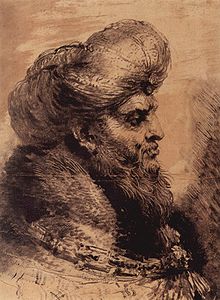Monotype
Monotype is a process in the visual arts that was probably invented by Giovanni Benedetto Castiglione (1616–1670) in the 17th century .
Instead of paper or canvas , drawings or paintings are made on glass , igelite , acrylic or metal plates and, as long as the paint is still damp, printed on the paper using a press or hand rubbing. If this is done with a printing press, the print has a plate edge like a gravure print .
The image design takes place as a printing process either through selective application of the color or through selective pressing on or through the printing material, for example thin paper. The motif is painted on metal with damp paint, the print is made while the paint is still wet.
An alternative monotype technique works as follows: A very thin piece of paper is placed on a glass, stone or acrylic plate that has been rolled in absolutely evenly with a printing ink (for example offset printing ink , available as a remainder from a print shop ). The motif is drawn on the top (actually back) side of the paper.
It can be sketched out on the rolled plate before it is placed on it. Soft drawing implements , such as graphite chalk , produce a soft, velvety line, while hard ones, such as a ballpoint pen , produce a correspondingly clear line on the underside. Halftones are created by rubbing with the thumb or the ball of the hand or by using colored areas with different levels of fat content. When using oil paints, shading by dabbing with a cloth or thinning the paint with turpentine is also possible, and when printing / hand rubbing on tissue paper and similar material, the prints appear similar to a lithograph.
Multi-colored monotypes can be obtained with new or additionally rolled-in glass plates with additional colors.
The combination of both techniques achieves attractive results.
By lining up monotypes vertically and horizontally, you get mosaics that exert a special charm.
The monotype (“a single image”) is therefore clearly unique and cannot be attributed to conventional printmaking , since the main feature of printmaking, the production of any number of (almost) identical images, each of which is an original, is not given.
It is not the printing form that determines the image, but the way in which the color is applied to and removed from a flat surface. The connection to the printmaking can be seen in the fact that the picture surface is not processed directly, but in an indirect way.
The monotype is therefore a combination of painting , drawing and graphics .
See also
literature
- Walter Koschatzky : The art of graphics: technology, history, masterpieces (= dtv paperback . Volume 30742 ). 14th edition. dtv , Munich 2003, ISBN 978-3-423-30742-0 .
- Jonas Beyer: Between drawing and printing: Edgar Degas and the rediscovery of the monotype in the 19th century . Fink, Paderborn 2014, ISBN 978-3-7705-5568-0 (406 pages with illustrations, dissertation Freie Universität Berlin 2012, table of contents , short code ).

